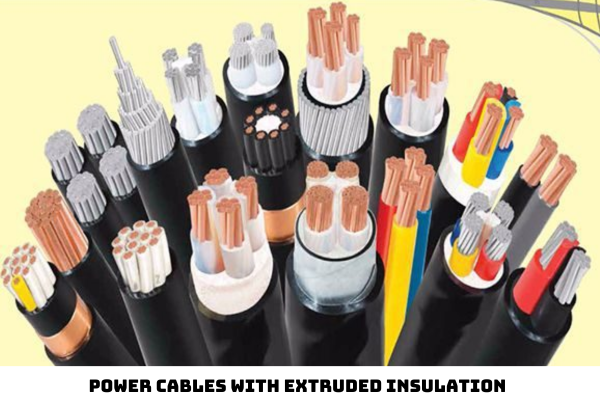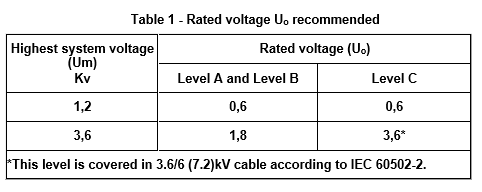What is Vietnam Standard TCVN 5935-1: 2013 on power cables with extruded insulation and their accessories for rated voltages from 1kV up to 30kV about?
- What is Vietnam Standard TCVN 5935-1: 2013 on power cables with extruded insulation and their accessories for rated voltages from 1kV up to 30kV about?
- What are the regulations on rated voltage symbols specified in Vietnam Standard TCVN 5935-1: 2013?
- What are the regulations on power cables with rated voltage of 0.6/1 (1.2) kV in Vietnam?
What is Vietnam Standard TCVN 5935-1: 2013 on power cables with extruded insulation and their accessories for rated voltages from 1kV up to 30kV about?
Vietnam Standard TCVN 5935-1: 2013 and Vietnam Standard TCVN 5935-2: 2013 replace TCVN 5935: 1995.
Vietnam Standard TCVN 5935-1: 2013 is fully equivalent to IEC 60502-1:2009.
Vietnam Standard TCVN 5935-1: 2013 is compiled by the Technical Committee of Vietnam Standard TCVN/TC/E4 power wires and cables, proposed by the Directorate of Standards, Metrology and Quality, and announced by the Ministry of Science and Technology.
Vietnam Standard TCVN 5935 (IEC 60502) on Power cables with extruded insulation and their accessories for rated voltages from 1kV (Um = 1,2kV) up to 30kV (Um = 36kV) includes the following parts:
Vietnam Standard TCVN 5935-1:2013 (IEC 60502-1:2009), Part 1: Cables for rated voltages of 1kV (Um = 1,2kV) and 3kV (Um = 3,6kV)
Vietnam Standard TCVN 5935-2:2013 (IEC 60502-2:2005), Part 2: Cables for rated voltages from 6kV (Um = 7,2 kV) and 30 kV (UM = 36 kV
Vietnam Standard TCVN 5935-4:2013 (IEC 60502-4:2005), Part 4: Test requirements on accessories for cables with rated voltages from 6 kV (Um = 7,2 kV) and 30 kV (Um = 36 kV)
Vietnam Standard TCVN 5935-1: 2013 specifies requirements for structure, size and testing of power cables with extruded insulation and their accessories for rated voltages from 1kV (Um = 1,2kV) up to 30kV (Um = 36kV) for fixed installations such as distribution grids or industrial installations.
Vietnam Standard TCVN 5935-1: 2013 refers to cables with the characteristics of fire spread reduction, low smoke emission and no halogen emission when burned.
Cables for special installations and special operating conditions are not covered by this Standard, such as cables for overhead lines, mining industries, nuclear power plants (in and around contaminated areas), cables for undersea use, or shipboard applications.

What are the regulations on rated voltage symbols specified in Vietnam Standard TCVN 5935-1: 2013?
Under Subsection 4.1 Section 4 of Vietnam Standard TCVN 5935-1: 2013, rated voltage symbols are specified as follows:
The rated voltage Uo/U(Um) of the cable considered in this standard is 0.6/1 (1.2) kV and 1.8/3 (3.6) kV.
Note 1 to entry: The above-mentioned voltages are the correct symbols although in some countries other symbols are used, e.g. 1.7/3 kV or 1.9/3.3 kV instead of 1.8/3 kV.
In the voltage designation of the Uo/U(Um) cable:
- Uo is the industrial frequency-rated voltage between the conductor and the ground or metal screen for which the cable is designed;
- U is the industrial frequency-rated voltage between the conductors for which the cable is designed;
- Um is the highest value of the "highest system voltage" that the device is allowed to use (see IEC 60038).
The rated voltage of the cable for the given application must be appropriate to the working conditions in the system in which the cable is used. For the convenience of choosing a cable, the system is divided into the following three levels:
- Level A: This level includes systems in which the phase wire when touching the ground or touching the ground wire is disconnected from the system within 1 min;
- Level B: This level includes systems that in the event of an incident still work for some time with a ground touchdown. According to IEC 60183, this time should not exceed 1h. For cables covered by this standard, longer intervals but not exceeding 8h are acceptable under any circumstances. The total time of occurrence of a touchdown incident in any one year should not exceed 125 hours;
- Level C: This level includes all systems that are not of level A or B.
Note 2 to entry: It should be known that in a system where a ground fault is not isolated automatically and quickly, abnormal stresses on the cable's insulation during a ground fault will reduce the life of the cable to a certain extent. If the system is expected to work quite often with prolonged ground failures, then it should be classified at level C.
The recommended Uo values for cables used in three-phase systems are listed in the table below:

What are the regulations on power cables with rated voltage of 0.6/1 (1.2) kV in Vietnam?
Under subsection 7.2 Section 7 of Vietnam Standard TCVN 5935-1: 2013, power cables with rated voltage of 0.6/1 (1.2) kV in Vietnam are specified as follows:
Cables with rated voltage of 0.6/1 (1.2) kV may have a common metal layer around the cores.
Note: Choosing between cables with and without metal layers depends on national regulations and installation requirements to prevent possible danger from mechanical failure or direct electrical contact.
- Cables with a common metal layer (see Article 8):
The cable must have an inner sheath surrounding the arranged core. The inner cladding and filler shall conform to 7.1.
However, the metal cuff may be placed directly onto the assembled core, removing the inner sheath provided that the nominal thickness of each cuff does not exceed 0.3 mm and the complete cable conforms to the special bending test specified in 18.17.
- Cables without common metal layers (see Article 8):
The inner sheath can be removed provided that the outer shape of the cable remains essentially round and does not stick between the cores and the sheath.
The outer sheath can penetrate into the gaps between the cores, except in cases where the outer sheath is thermoplastic wrapped with a circular core larger than 10 mm2.
However, if there is an inner cladding, then the thickness of this cladding does not need to match 7.1.3 or 7.1.4.
LawNet